WOUNDED CITY
A weekend of gun violence in Philadelphia shows the incalculable, yet cruelly normal, level of trauma that residents must endure.

This article contains images depicting the aftermath of violence.
One in an occasional series about Philadelphia’s unchecked gun violence.
Screams echoed across the North Philadelphia block, piercing the quiet of a warm summer night.
“Diniar!” Kathi Camp cried. “Get up!”
The body of her 26-year-old son lay in the street, covered by a white sheet. Three hours earlier, Diniar Camp had walked a young woman home, and police say her ex-boyfriend, in a jealous rage, fatally shot him.
Kathi Camp, held by a police officer, went limp and fell to the ground. She would be hospitalized later that night, overcome by grief.
Diniar’s father, Steven Green, rushed to his youngest child, struggling as police held him back.
“Shoot me!” Green gasped. “Shoot me!”
He ripped from their grasp, dropped to his knees, and draped his arms across Diniar’s body.
He lifted his head and bellowed to the sky: “My son!”

It was another night in Philadelphia’s relentless gun violence crisis.
Day after day, hour after hour, Philadelphians are being shot at a pace unprecedented in city history.
Last year, more than 560 people were killed in homicides — the overwhelming majority by guns — and another 1,800 were wounded by bullets. It was the city’s most violent year ever.
This year’s pace has been worse.
This summer alone was the deadliest on record. Between Memorial Day and Labor Day, nearly eight people on average were shot every day — a rate more than twice that of five years ago. More women and children were shot than ever before.
Resources
Thousands of Philadelphians have been affected by gun violence. If you or someone you know needs support, whether financially or emotionally, here is a list of resources.
To capture just a glimpse of the summer’s epidemic and document its unrelenting toll, Inquirer journalists in early August visited the scene of every shooting during a single weekend in nearly real-time. In the weeks that followed, they attended funerals, spoke with survivors as they sought to heal, visited with neighbors afraid to leave their homes, and tried to understand why the shootings occurred.
Their reporting presents a microcosm of the violence many Philadelphians endure every single day, and what’s driving it: people using guns to resolve trivial disagreements; only one in four shootings resulting in charges; unsolved shootings festering and leading to threats of retaliation; neighborhood groups beefing over social media; and untold grieving families and shooting survivors facing searing trauma in the aftermath.
And yet that weekend’s gun violence was cruelly average.
From Friday evening Aug. 5 through late Sunday, 20 people were shot.
Six of the victims were women. Fourteen were men. Two were teenagers.
In at least three cases, children witnessed their parents getting shot.
All were people of color.
In its grim wake, far too many lives would never be the same.
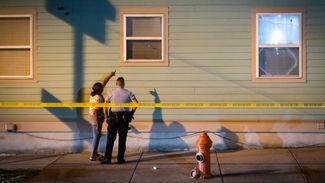



Friday, 8:57 p.m.
‘Catch him before we do’
Aatif Fortune felt relaxed as he strolled through his Southwest Philadelphia neighborhood, with his rottweiler, O’Hana, on a leash and 12-year-old son by his side, riding a bike.
It was about 8:30 p.m., and with the air calm and in the low-80s, families had gathered on their rowhouse stoops to grill and drink. Fortune, 37, stopped by a friend’s house up the block to chat, while a group of about 10 kids played in the street, on the 6300 block of Paschall Avenue.
Suddenly, a friend of the family across the street — a man Fortune and his friends did not know — stormed over, yelling that two of their sons said something mean to a young girl in his family. Fortune’s friend and the man argued, but eventually, the man retreated back across the street.
A few minutes later, Fortune walked over to diffuse the tension and explain there was a misunderstanding, he said. But before he could speak, the man pulled out a handgun and shot at him.
Fortune ran away down the block, but the man chased him, and fired at least six times as neighbors and children dove to the ground. Fortune’s young son watched in terror as his father was being hunted.
Fortune was shot once in the upper right thigh. He ran for nearly a mile, blood streaming down his leg, the bullets seemingly whizzing past his head, before he felt safe enough to stop and seek help. A friend drove him to Penn Presbyterian Hospital, where he received brief treatment.
When police arrived at the crime scene they found a trail of blood, and a group of residents in an uproar, pointing toward the house-turned-restaurant where they said they saw the shooter retreat.
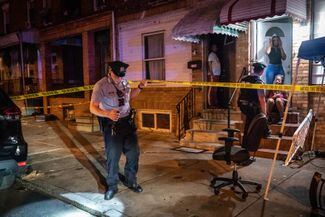
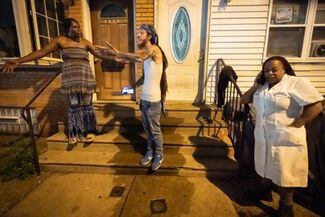

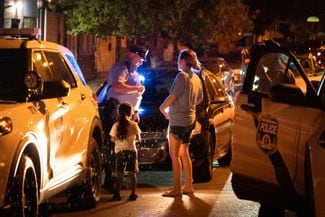
But a woman who lived in that house told officers she saw nothing and didn’t know what they were talking about.
Meanwhile, Fortune’s friend, pacing in the street, warned officers, “I hope y’all catch him before we do.”
It was a small case study in the struggle to contain Philadelphia’s gun violence: A mundane argument leading to gunfire; a code of silence protecting the shooter; and victims, feeling little hope that justice will be served, threatening to take matters into their own hands.
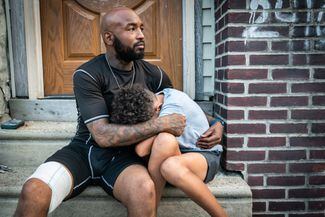
“In a majority of shootings, people know who did it,” Capt. John Walker, head of the Police Department’s nonfatal shooting unit, would later explain. “They are going to allow themselves to digest it a bit first, and then decide what way they’re going to go: are they going to let law enforcement handle it, the streets handle it, or handle it themselves?”
Increasingly, people opt for the latter two. While the Police Department does not compile data on the motives behind nonfatal shootings, nearly 20% of homicides last year were retaliatory, determined to be motivated by revenge against someone for a past assault or insult, or an attack against a rival group over a perceived beef. This motive saw a 145% jump over the year before, according to police statistics.
Fortune, who as a younger man was convicted for crimes including selling drugs, illegal gun possession and assault, said he has turned his life around and now works for a construction company. He will recover physically, but his son is traumatized, afraid to return to his dad’s house and unable to sleep alone without nightmares.
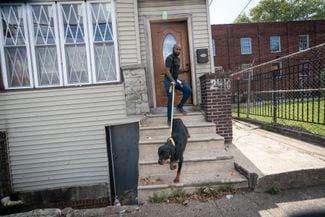
For that reason, Fortune said, he cannot move on. He won’t retaliate himself, but if others among his friends and family do, so be it.
“I don’t feel nothing for his family,” he said of the shooter.
“I don’t want a massacre. That’s not what I want,” he said. “I’ve been shot in front of my kid, in front of my baby’s mom. If nobody can help me, then it will be.”
The shooter apparently knew it, too.
The man — later identified by police as Danzouma Sango — fled the state. Police would catch Sango in Ohio two weeks later, as he attempted to get on a flight to the Bahamas. He remains in custody at Philadelphia’s county correctional facility, and faces aggravated assault and gun charges.
Before midnight, five more people would be shot.
A 17-year-old shot in the leg while walking home from his local recreation center.
A 20-year-old woman shot in the pelvis while playing cards on a North Philadelphia porch.
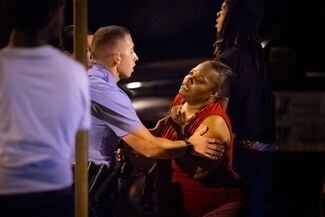


10:31 p.m.
A 6-year-old loses his ‘best friend’
In Franklinville, shortly after 10:30 p.m., a group of friends hung out on the sidewalk of the 3500 block of Warnock Street, drinking and chatting. But just around the corner lurked three men with guns and a vengeance.
The men quietly got out of their car, then ran up and unleashed 21 shots at the group, striking three of them.
Daquan Gibbs, 29, was shot four times, including once in the head. He died the next day.
In the weeks that followed, Gibbs’ family would struggle to process losing the man they called their linchpin, and wonder how they would tell Gibbs’ 6-year-old son, Noah, that his father was dead.
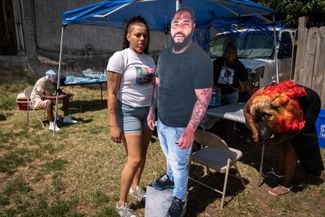

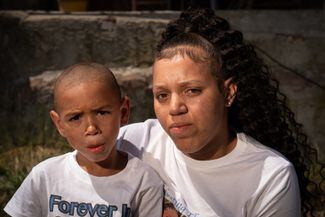
On Aug. 19, as loved ones gathered at Nix and Nix Funeral Home, Noah stayed at his mother’s side, calm and still. But as funeral staffers slowly latched the casket closed, Noah collapsed into his mother’s skirt and wept.
“That was his best friend,” Namiyah Phillips said, gently rubbing her son’s back.
Donna Gibbs could not bring herself to speak at her son’s service. Privately, she said only one thing could bring her solace.
“Catch whoever did it.”
In September, police did: David Daniels Jr. and Nasir Nixon, both 22, were arrested and charged with murder.
Detectives’ working theory of the case is that the crime may have been retaliatory — payback for the shooting death of a pregnant woman in Tioga in May. It was unclear who in the group, if anyone, played a role in that shooting, said Homicide Capt. Jason Smith.
The arrest was a brief moment of relief for Donna Gibbs.
In Philadelphia, that is a rarity. A fraction of the city’s homicides and shootings result in charges, and even fewer end in convictions. With hundreds of cases unsolved each year, families are often left without closure — while shooters remain on the street.
For this weekend, homicide detectives would have more success. They made arrests or developed suspects in all four homicides, a tribute, Smith said, to the department’s persistence.
12:24 a.m.
‘He didn’t deserve this’
Friday evening, after the funeral of a close friend fatally shot one week earlier, Diniar Camp, 26, and some friends spent a couple of hours at a North Philadelphia hookah lounge. He had just returned to the area five days earlier, from Reno, Nev., where he had moved in April to pursue his music career and escape the city’s escalating gun violence.
Shortly after midnight, Camp offered to walk a young woman to her home, three blocks away, on the 1900 block of North 19th Street.
But outside the woman’s house, her ex-boyfriend — a man police later identified as Marcus Michael Whitehead, 22 — waited in a truck, watching as Camp and the woman neared her house.
Before the two reached the front door, Whitehead was out of the truck, gun in hand, police say. He shot at them eight times, striking Camp at least twice.
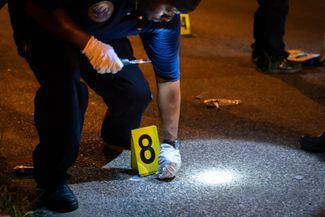
Camp carried his legally registered handgun that night, but didn’t pull it in time. He died on the scene, his Glock on the ground next to him, a bullet in the chamber.
Whitehead remains a fugitive.
More on Philly’s gun crisis
Family and friends described Camp as a talented singer, practical jokester, and giving friend. In the weeks after his death, they struggled to fully grasp how he could be killed so senselessly.
“He was a good boy,” said his mother, Kathi Camp. “He didn’t deserve this.”
Two weeks later, Kathi and her husband Steven Green walked down the aisle of Bethany Evangelical Presbyterian Church, past pews filled with loved ones, and toward an open casket.

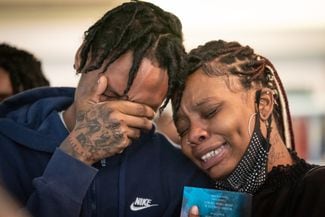
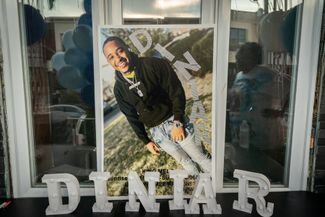
At the sight of his son’s body, dressed in a tan suit and periwinkle bow tie, Green balled his fists and inhaled deeply. Could he have done more to protect him? he wondered aloud.
And as the service ended, Kathi Camp sought final tender moments with her youngest child. She gently adjusted the black crown atop his head and smoothed his jacket. She brushed his cheek, and paused to take in his handsome face. Then she pulled the white shroud over his body and a blue cloth atop his face, and slowly closed the casket.
“My baby,” she cried, over and over.
The day after Diniar Camp’s killing, the city was still.
No one was shot for 22 hours.


Saturday night, 10:15 p.m.
Kensington’s cruel norm
But shortly after 10 p.m., gunfire erupted, this time on the 1800 block of Hart Lane in Kensington. Two people were injured: a 34-year-old woman shot multiple times in the torso and arm, and a 37-year-old man with a graze wound to his neck.
In a city where more than 12,500 people have been shot since 2015, no neighborhood has been as burdened by shootings as Kensington, a section of Philadelphia beset by an open-air drug market and higher concentrations of poverty and addiction. In this single weekend, four people were shot there.
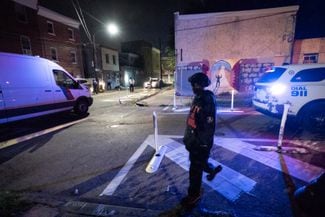
Drugs are traditionally a driving force behind homicides. Last year, police say, they motivated about one in five killings citywide.
And on this block of Hart Lane, which intersects with the bustling Kensington Avenue drug corridor, 16 people have been shot in the past three years. It is among the 57 blocks in Philadelphia that saw 10 or more people shot since 2015.
One of Saturday’s victims — the man grazed in the neck — would later say he was fine and recovering, but otherwise declined to speak about the incident. The woman who was shot could not be reached, and the address she gave law enforcement was vacant.
2:15 a.m.
Escalating social media beefs
Four miles away in Brewerytown, an ambush was brewing.
It was 2:15 a.m., and three young women were driving to the 1300 block of Newkirk Street, to meet up with a boyfriend and attend a party at an Airbnb.
But two gunmen hid in a dark vacant lot, waiting. Before the women could put the white BMW in park, the men jumped out and started shooting.
The scene was harrowing: The car had been struck by at least 30 bullets. Blood was splattered across the interior. At least seven more shots hit nearby vehicles and burst through a church window.
Miraculously, all the women, ages 19 to 21, survived, including one who was shot nine times, in the back, neck, and face.
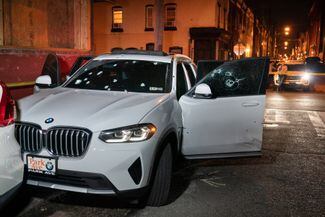
Law enforcement said the shooting was sparked by a feud over Instagram between two neighborhood gangs. The women were less of a target than the car itself, which the shooters associated with a rival group, said William Fritze, an assistant district attorney who heads the Gun Violence Task Force in the DA’s Office.
By shooting up the car, Fritze said, the gunmen would make a statement and maybe take out an enemy. Anyone else hit, related or not, was collateral damage.
“The street code is gone,” Fritze said. “It’s ‘We’re just going to go out and shoot.’”
More on Philly’s gun crisis
In Philadelphia, there are no gangs in the traditional, nationally known sense. Instead, they are cliques of young men affiliated with certain neighborhoods and families. The groups have names — Young Bag Chasers, Penntown, Northside — and members carry an allegiance to each other, but they aren’t committing traditional organized crimes, like moving drugs, the way gangs did in the past.
Fritze, though, said it’s time to call them what they are: “I think we are now at a point where we can comfortably say there are gangs.”
Beef between rival crews sometimes goes back years. But increasingly, he said, the feuds are fueled by — and chronicled on — social media, particularly Instagram. Members of one group often make posts or livestreams mocking and claiming the shootings of people in rival crews as a way to build street cred.
And while arguments in the past were hashed out in person and stayed within one neighborhood, slights posted on social media and rapped in songs are permanent, public challenges for all to see. And the social pressure on a crew to defend its reputation is immediate and often deadly.
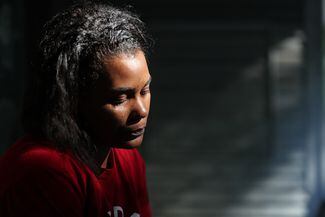
Sunday, 2:26 a.m.
A mother wonders where she’s safe
As Saturday night faded to Sunday morning, Antoinette Arter was watching TV in bed at her Germantown home.
But then her 18-year-old daughter Anaiyah’s scream shook the house. A man in a mask with a gun was at the door, trying to break in.
Arter, a 37-year-old nurse, ran down the stairs, but when she heard two gunshots, she said, she sprinted back up. Her daughter hid in the back of the house, while Arter climbed out her bedroom window and onto the neighbors’ awning, then banged on their window for help.
That’s when she noticed the blood spilling down her leg.
Arter had been shot in the thigh and buttocks.
After several hours, she was released from Einstein Medical Center. When she arrived home in the morning light, still dressed in her hospital socks, she sat on her porch for hours, too traumatized to go inside.
“I’m not out in the streets, I’m not a troublemaker,” she would later say. “If you can’t be safe at home, where can you be safe?”
More than a month later, Arter still can’t sleep and walks with a limp. She’s browsing the housing market, looking for a new home and neighborhood, away from where she was shot.
“Mentally,” she said, “it’s going to take a lifetime to recover.”
The detective on her case remained in touch at first, she said. But aside from those first few calls, she hasn’t heard from anyone from the city or received updates on the case. It remains unsolved.
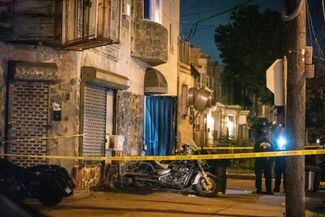
3:19 a.m.
Another homicide
Back in Southwest Philadelphia, members of the Last Standin Motorcycle Club bumped to music inside of a speakeasy on the 5300 block of Greenway Avenue.
Club member Rashod Carroll, 37, manned the door. Shortly after 3:15 a.m., he let two women inside, and then a man walked up. According to video recovered by police, the man showed something to Carroll, potentially an entry card for the bar, but as Carroll opened the door and turned around, the man pulled out a gun, and shot Carroll once in the back of the head.
As the shooter fled, he shot Carroll once more in the back. Carroll died shortly after at Penn Presbyterian Hospital. He was buried Aug. 16 at Fernwood Cemetery.
Detectives believe Carroll’s killing was retaliation for a fight the day before. A suspect has been identified, Smith said.
6:30 a.m.
Bar fight turned gun fight
And three hours later, gunfire erupted again in Kensington, on the 1800 block of East Cumberland Street, after two men arguing outside of a bar pulled guns on each other. A 34-year-old man, Robert Bush, was shot in the arm and thigh.
Before the cops arrived, Bush took off.
Arguments have long been a leading cause of shootings in Philadelphia, according to police. Last year, they were the motive in nearly a third of the city’s homicides. With more and more residents armed, what were once fist fights now easily devolve into gunfights.

Bush walked himself more than a mile to the Temple emergency room.
Within a few days, police recovered video from outside the bar. They said it showed that Bush fired at the man who shot him, but missed.
Bush has been convicted of felonies, including robbery, and is prohibited from carrying a gun. So police charged him with illegal gun possession and related crimes, and learned that he had an outstanding arrest warrant for an aggravated assault in Johnstown, Pa.
But Philadelphia prosecutors withdrew the case on Wednesday, after police officers who were scheduled to testify failed to appear at two different hearings, according to court records. Bush’s lawyer declined to comment.
Police said they have clear video of the other shooter, but have not located him.
2:39 p.m.
‘We’re going to be next’
Sunday afternoon, as children played in the courtyard of the Spring Garden Apartments, three gunmen strode toward a father and unleashed 32 bullets.
Once the gunfire stopped, residents took action. They knew what to do. At this complex, where at least 14 people have been shot since 2015, it had become an all-too-familiar scene.
Was anyone shot? someone asked, scanning the yard.
Yes — there he is. The man from apartment 609.
Lift him up. Don’t drop him, one said. Keep him awake.
Their 41-year-old neighbor, Tyree Mayo, had been shot in the head. They carried his body to a police cruiser, and placed him in the backseat. An officer sped him to Jefferson Hospital.
It was one of several cases that weekend of “scoop and run,” a Philadelphia police practice to get victims to the hospital as soon as possible without waiting for medics. Police have saved lives this way, and a study found that two-thirds of Philly shooting victims arrive at hospitals in cop cars.
But Mayo’s trauma was too severe. He died two hours later.
Detectives believe Mayo was targeted over an argument stemming from a previous fight involving children, said Homicide Capt. Jason Smith. He declined to elaborate, citing the case’s sensitive nature, but said it wasn’t domestic, and detectives have strong direction and a suspect.
In the aftermath, two residents of the public housing complex, their clothes covered in Mayo’s blood, talked about a similar scene in the courtyard less than a month earlier — when four young teenagers were shot over what police described as ongoing feuds between nearby groups.
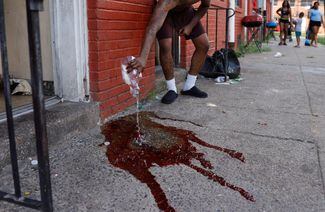
Residents are left to constantly worry when — not if — the next shots will fly. One woman said she would have moved away long ago, if she had the means. Instead, she said, she’s trapped here.
“If we don’t go, we’re going to be next,” said the woman who, like others at the complex, asked not to be named for fear of reprisal.
As she swept up glass from the shattered windows, another neighbor poured water from a Simply Lemonade bottle onto the blood pooled on the sidewalk.
“I don’t want his kids to see this when they get home,” he said.
Mayo’s mother and two children lived with him. They couldn’t be reached — immediately after the shooting, they packed up and moved out.
Monday, 1:45 a.m.
No resources, no hope
Esther Levine was half asleep when her youngest grandson held the phone up to her ear.
It was her daughter. She was at the hospital. Levine’s 21-year-old grandson had been shot.
“I thought he was dead,” said Levine, 67.
Levine’s grandson explained to her that, around 1:30 a.m., someone shot at him at least five times as he and a friend walked through North Philadelphia. He was hit once in the ribs. When the shots rang out, he told her, he ran as far and fast as he could. Police found him on the 4300 block of North Sixth Street, and took him to Temple Hospital.
“By the grace of God, he is still here,” Levine said.
Subscribe to The Philadelphia Inquirer
Our reporting is directly supported by reader subscriptions. If you want more journalism like this story, please subscribe today.
Levine remains unsettled by the lack of outreach provided to her grandson in the aftermath. He has been convicted once for selling drugs and has another open case winding through the courts. He needs guidance and help finding a job, Levine said. But after the shooting, only one man from a nonprofit came by to offer mentorship resources, she said.
“Nobody came out to say nothing,” she said. “It’s so disturbing to me.”
It shows, she said, that the city “don’t give a damn about Black young people.”
“Everybody got signs up of ‘Black Lives Matter,’” she said. “But if they did care, if they really, really cared, somebody would have been out here, the city would have been out here to extend their hand out to my grandson, for comfort or something.”

Picking up the pieces
The weekend was over.
But for survivors and grieving families, the pain was just beginning.
Antoinette Arter struggled to sleep through the night. Donna Gibbs wondered what words she would use to explain to her grandson how his father died. Residents of the Spring Garden Apartments prepared for the likelihood that more bullets would fly.
And Kathi Camp was shattered, but determined to devote her life to keeping her son’s memory alive. She hopes to start a foundation to support aspiring musicians, and has joined other mothers fighting to persuade local leaders to devote more resources to stopping the violence.
Because it’s urgent.
In the weeks since her son’s death, 300 more people were shot.
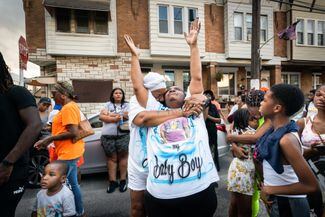
About this story
To report this story, Inquirer journalists visited the scene of every shooting in Philadelphia over the course of one summer weekend, from 6 p.m. Friday, Aug. 5 to 4 a.m. Monday, Aug. 8. Relying on police broadcast scanners and other communications, they reported on the events as they unfolded, interviewing neighbors, shooting victims, family members, Philadelphia police officials, prosecutors, and others — more than 75 in all. They reviewed police and court records, as well as police data detailing thousands of recent shootings. The journalists attended funerals only with the consent of families. While most people spoke on the record, reporters protected the identities of those in a handful of cases who feared being named. When survivors declined to speak or couldn’t be reached, reporters based shooting incidents on what they observed or on police records.
One Summer Weekend in Philadelphia
From late Friday, Aug. 5, to late Sunday, Aug. 7, 20 people were shot, four of them fatally. There were a record 791 shootings from Memorial Day weekend to Labor Day.

Acknowledgment
The Inquirer’s journalism is supported in part by The Lenfest Institute for Journalism and readers like you. News and Editorial content is created independently of The Inquirer’s donors. Gifts to support The Inquirer’s high-impact journalism can be made at inquirer.com/donate. A list of Lenfest Institute donors can be found at lenfestinstitute.org/supporters.
Staff Contributors
- Reporters: Ellie Rushing, Ximena Conde, Chris Palmer, Dylan Purcell
- Editors: Nancy Phillips, James Neff
- Photographers: Jessica Griffin, David Maialetti, Elizabeth Robertson
- Photo Editor: Danese Kenon
- Digital Editors: Patricia Madej, Felicia Gans Sobey, Dain Saint
- Copy Editing: Rich Barron
- Social Platforms Editor: Erin Gavle
- Graphic Artist: Steve Madden